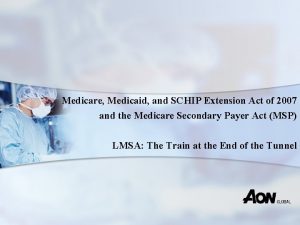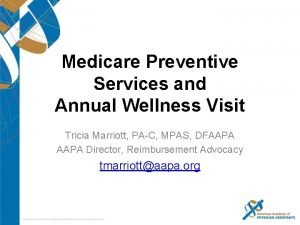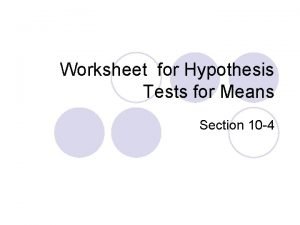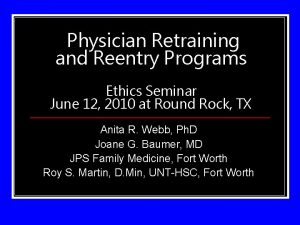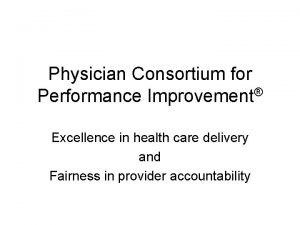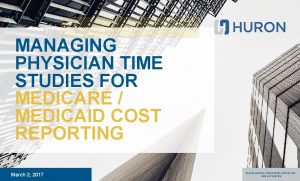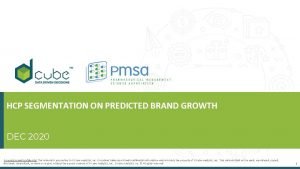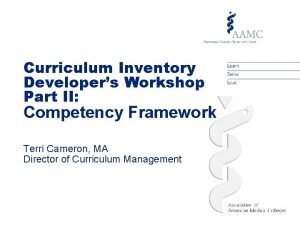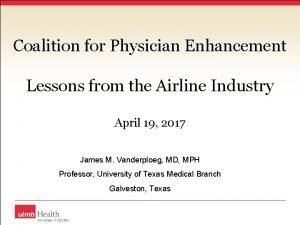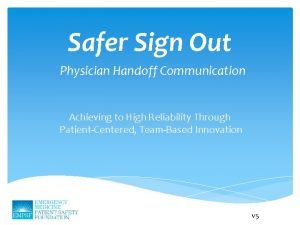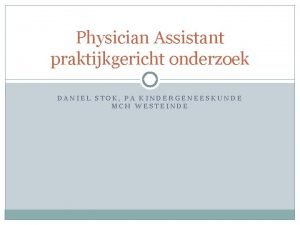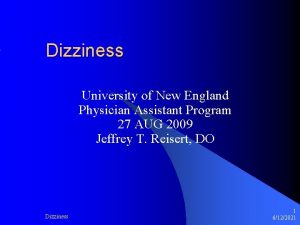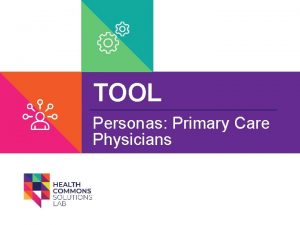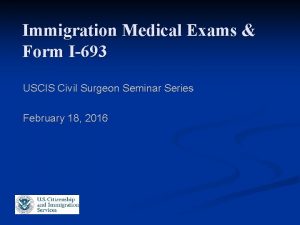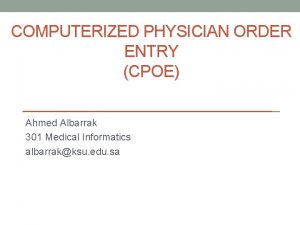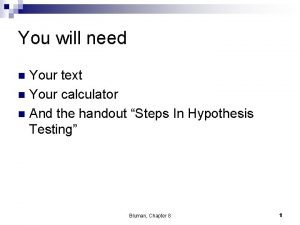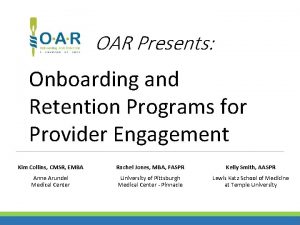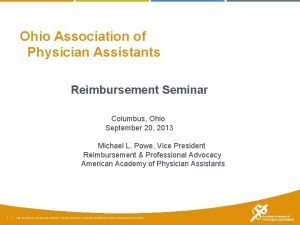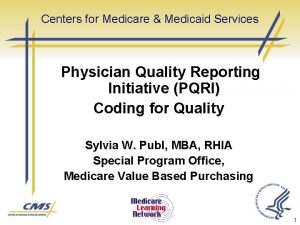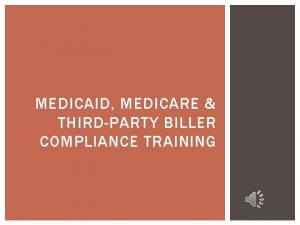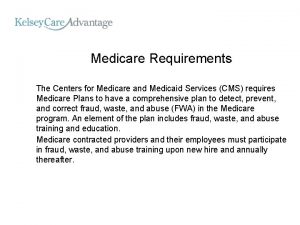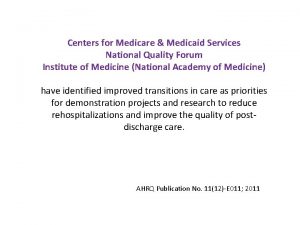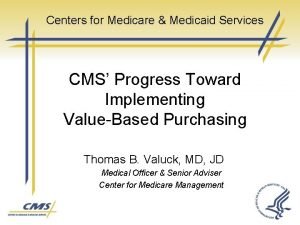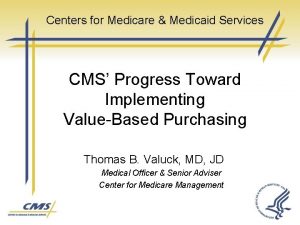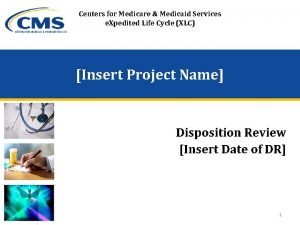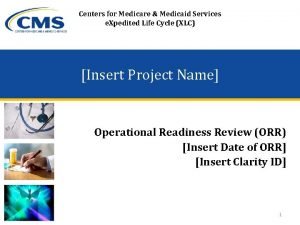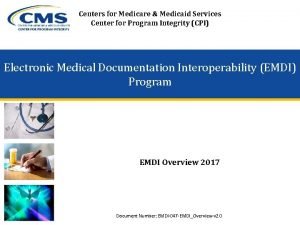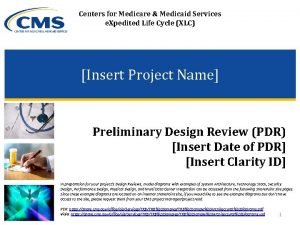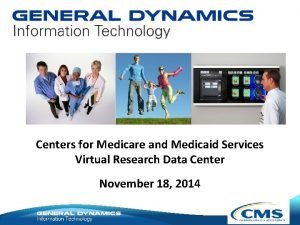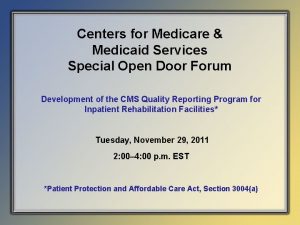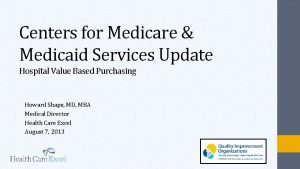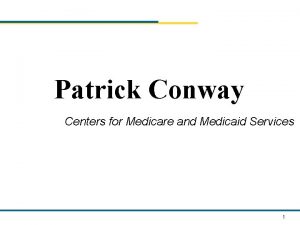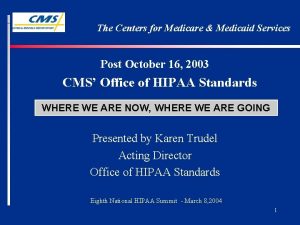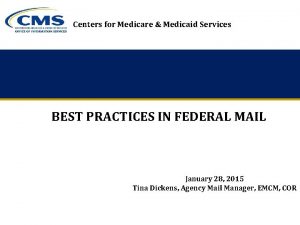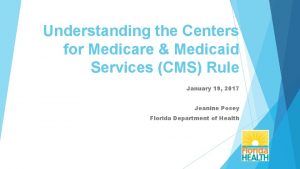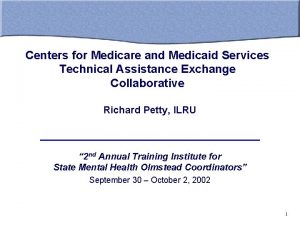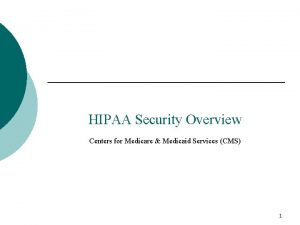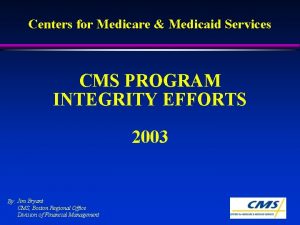Centers for Medicare Medicaid Services 2007 Physician Quality











































- Slides: 43

Centers for Medicare & Medicaid Services 2007 Physician Quality Reporting Initiative (PQRI) ASGE June 4, 2007 1

PQRI Overview • • • Value-Based Purchasing and the PQRI Introduction Measures Coding for Quality Practice Readiness Educational Tools and Resources 2

Value-Based Purchasing and PQRI • Value-based purchasing is a key mechanism for transforming Medicare from a passive payer to an active purchaser. – Current Medicare Physician Fee Schedule is based on quantity and resources consumed, NOT quality or value of services. • Value = Quality / Cost – Incentives can encourage higher quality and avoidance of unnecessary costs to enhance the value of care. 3

Quality and PQRI • PQRI reporting will focus attention on quality of care. – Foundation is evidence-based measures developed by professionals. – Reporting data for quality measurement is rewarded with financial incentive. – Measurement enables improvements in care. – Reporting is the first step toward pay for performance. 4

PQRI Introduction: The Statute • Tax Relief and Healthcare Act (TRHCA) Division B, Title I, Section 101 provides statutory authority for PQRI and defines: – – – – Eligible professionals Quality measures Form and manner of reporting Determination of satisfactory reporting Bonus payment calculation Validation Appeals 5

PQRI Introduction: Eligible Professionals • Physicians – MD/DO – Podiatrist – Optometrist – Oral Surgeon – Dentist – Chiropractor • Practitioners – Physician Assistant – Nurse Practitioner – Clinical Nurse Specialist – Certified Registered Nurse Anesthetist – Certified Nurse Midwife – Clinical Social Worker • Therapists – Clinical Psychologist – Physical Therapist – Registered Dietician – Occupational Therapist – Nutrition Professional – Qualified Speech. Language Pathologist 6

PQRI Introduction: The Quality Measures • Final list of 74 quality measure statements, descriptions, and detailed specifications now posted at: www. cms. hhs. gov/PQRI. • Specifications will be updated and reposted prior to the July 1, 2007 start date to expand the applicability of the measures. 7

PQRI Introduction: Successful Reporting • If 4 or more measures are applicable to the practice, practitioner must report at least 3 of them correctly for 80 percent of cases (visits or patients, depending on measure). • If 3 or fewer measures are applicable to the practice, practitioner must report each of them correctly for 80 percent of the cases (visits or patients, depending on measure). 8

PQRI Introduction: The Bonus Payment • Professionals that report successfully are eligible for a 1. 5 percent bonus payment, subject to a cap. • Potential bonus payment is calculated using total allowed charges for covered professional services furnished during the reporting period and paid under the Physician Fee Schedule. • The cap will be calculated at the end of the reporting period by multiplying the National Average per Measure Payment Amount (National total charges associated with quality measures /National total instances of reporting) x 300% x Individual’s instances of reporting quality data. 9

PQRI Introduction: Validation and Appeals • Validation – The statute requires CMS to use sampling or other means to validate whether the required minimum number of quality measures applicable to the services have been reported. • Appeals – The statute excludes PQRI-related determinations from formal administrative or judicial review. 10

PQRI Introduction: Key Information • Reporting period: Dates of service July 1, 2007 through December 31, 2007. • No need to register: Just begin reporting. • Must be an enrolled Medicare provider (but need not have signed a Medicare participation agreement). • Need to use individual National Provider Identifier (NPI). 11

PQRI Introduction: The PQRI Website • www. cms. hhs. gov/PQRI – – – – Overview CMS Sponsored Calls Statute/Regulations/Program Instructions Eligible Professionals Measures/Codes Reporting Analysis and Payment Educational Resources 12

PQRI Introduction: The Tools • Gather information and educational materials from the PQRI website at: www. cms. hhs. gov/PQRI. • Change Request 5640 for coding and reporting principles. • Gather information from other sources, such as your professional association, specialty society, or the American Medical Association. 13

PQRI Reporting Understanding the Measures 14

PQRI Reporting: Selecting Measures • Review the 2007 PQRI measures list and specifications at: www. cms. hhs. gov/PQRI. – Click on the Measures/Codes link – Go to Downloads • Select measures that address the services you provide to patients. – Conditions you treat. – Types of care you provide – e. g. , preventive, chronic, acute. – Settings of care for your work – e. g. , office, ED, surgical suite. • Consider your quality improvement goals for 2007. 15

PQRI Reporting: Understanding the Measures • 74 unique measures. • Associated with clinical conditions that are routinely represented on Medicare Fee-for. Service (FFS) claims. • Based on diagnosis codes from ICD-9 -CM and procedural codes from the Health Care Common Procedure Coding System (HCPCS). 16

PQRI Reporting: Understanding the Specifications • Each measure has a reporting frequency requirement for each eligible patient seen during the reporting period. – Report one-time only – Report once for each procedure performed – Report for each acute episode 17

PQRI Reporting: Understanding the Specifications • Some measures have a performance timeframe related to the clinical action that may be distinct form the reporting frequency. – Perform within 12 months – Most recent 18

PQRI Reporting: Understanding the Quality Data Codes • CPT II codes (or temporary G codes used on an exception basis where CPT II codes have not yet been developed). • Quality data codes translate clinical actions so they can be captured in the administrative claims process. 19

PQRI Reporting: Understanding the Quality Data Codes • Quality data codes capture whether: – The measure requirement was met. – The measure requirement was not met due to documented allowable performance exclusions (i. e. , performance exclusion modifiers). – The measure requirement was not met and the reason is not documented in the medical record (i. e. , 8 P reporting modifier). 20

PQRI Reporting: Understanding the Modifiers • Performance measure exclusion modifiers indicate that an action specified in the measure was not provided due to medical, patient, or systems reason(s) documented in the medical record: – 1 P - performance measure exclusion modifier used due to medical reasons. – 2 P - performance measure exclusion modifier used due to patient reason. – 3 P - performance measure exclusion modifier used due to system reason. • One or more exclusions may be applicable for a given measure. Certain measures have no applicable exclusion modifiers. Refer to the measure specifications to determine the appropriate exclusion modifiers. 21

PQRI Reporting: Understanding the Modifiers • Performance measure reporting modifier facilitates reporting a case when the patient is eligible but the action described in a measure is not performed and the reason is not specified or documented. – 8 P - performance measure reporting modifier - action not performed, reason not otherwise specified. 22

PQRI Reporting Coding for Quality 23

PQRI Reporting: Coding for Quality • Two examples: – (GERD): Upper Endoscopy for Alarm Symptoms – GERD: Biopsy for Barrett’s Esophagus 24

Successful Reporting Scenario GERD: Upper Endoscopy for Patients with Alarm Symptoms • Performance Description: Percentage of patients aged 18 years and older with a diagnosis of GERD, seen for initial evaluation, with at least one alarm symptom* who were either referred for upper endoscopy or had upper endoscopy performed. • Reporting Description: Percentage of patients aged 18 years and older seen by the clinician and an applicable CPT Category II code reported once for all GERD patients seen for an initial evaluation during the reporting period. *Alarm symptoms include (involuntary weight loss, dysphagia, or gastrointestinal bleeding) 25

Successful Reporting Scenario GERD: Upper Endoscopy for Patients with Alarm Symptoms Mr. Jones presents for office visit with Dr. Thomas Mr. Jones was referred for possible endoscopy due to GERD symptoms with dysphagia. Situation 1: Dr. Thomas performs an upper endoscopy. CPT II code 3130 F and CPTII code 1071 F (alarm symptoms) Situation 2: Dr. Thomas documents that Mr. Jones declines the procedure. CPT II code 3130 F-2 P modifier and CPT II Code 1071 F Situation 3: There is no documentation that Dr. Thomas performed or referred Mr. Jones for endoscopy CPT II code 3130 F-8 P or 3132 F-8 P And 1071 F All of these situations represent successful PQRI reporting. 26

Successful Reporting Scenario GERD: Biopsy for Barrett’s Esophagus • Performance Description: Percentage of surgical patients aged 18 years and older with a diagnosis of GERD or heartburn whose upper endoscopy report indicates a suspicion of Barrett’s esophagus who had a forceps esophageal biopsy performed • Reporting Description: This measure is to be reported each time an upper endoscopy is performed during the reporting period. It is anticipated that the clinician who performed the exam will report this measure. 27

Successful Reporting Scenario GERD: Biopsy for Barrett’s Esophagus A 68 year old female presents to the GI lab for upper endoscopy. Scenario 1: Documentation of esophogeal biopsy being performed for suspicion of Barrett’s esophagus Scenario 2: Documentation of medical reason for not performing biopsy c CPT II code 4047 F -1 P And Scenario 3: Order for prophylactic antibiotic not documented, no reason specified. CPT II code 3150 F CPT II 3140 F CPT II code 3150 F 8 P and And Or CPT II 3140 F CPT II Code 3140 F CPT II 3141 F (no suspicion of BE) 28

PQRI Reporting: Data Submission • CPT Category II codes may be reported on paperbased 1500 or electronic 837 -P claims. • The CPT Category II code, which supplies the numerator, must be reported on the same claim form as the payment ICD-9 and CPT Category I codes, which supply the denominator of the measures. • Multiple CPT Category II codes can be reported on the same claim, as long as the corresponding denominator codes are also on that claim. 29

PQRI Reporting: Data Submission • Submitted charge field cannot be blank. – Line item charge should be $0. 00. – If system does not allow $0. 00 line item charge, use a small amount like $0. 01. • Entire claims with a zero charge are rejected. • Quality data code line items will be denied for payment but then passed through to the NCH file for PQRI analysis. 30

PQRI Reporting: Data Submission • The individual NPI of the participating professional must be properly used on the claim. • Multiple eligible professionals with their NPIs may be reported on the same claim with each quality data code line item corresponding to the services rendered by the professional for that encounter. • All claims must reach the NCH file by February 29, 2008 to be included in the bonus calculation. 31

PQRI Reporting: Tips for Success • Start reporting early to increase the probability of achieving the 80 percent rate of reporting during the reporting period. • Report on as many measures as possible to increase the likelihood of achieving successful reporting. • Report on as many eligible patients as you can to decrease the probability of being subject to the bonus cap. • Ensure that quality codes are reported on the same claim as the diagnosis or CPT I codes. 32

PQRI Implementation Practice Readiness 33

PQRI Implementation: Developing Reporting Process • Identify team that will develop reporting process; include members of office staff as well as clinicians. • Review steps for ongoing reporting in light of selected measures. • Consider what changes will need to be made to practice systems for each step. • Consider using worksheets, encounter forms, screen templates, or other tools for data capture. 34

Tool: Measure Description 35

Tool: Worksheet 36

Tool: Coding Specifications Current Procedural Terminology © 2006 American Medical Association. All Rights Reserved. 37

PQRI Implementation: Modifying Practice Systems • Depending on your reporting approach, you may need to: – Adopt, modify, or create PQRI worksheets (use or modify CMS worksheets or those created by a third party, if available). – Adopt, modify, or create billing sheet/superbill. – Adopt, modify, or create other paper materials. – Modify fields or capabilities of electronic medical record (EMR) system to include CPT II codes, G codes, or other capabilities. – Modify billing system to accept $0. 00 or $0. 01 charges for line items with quality codes. – Improve documentation of care provided. 38

PQRI Implementation: Test System Readiness • Eligible professionals interested in testing their billing system and practice readiness prior to July 1 will have an opportunity to do so. • CMS has designated code G 8300 as a test code for PQRI reporting for dates of service prior to July 1, 2007. Note that G 8300 will become 'Not Valid for Medicare Purposes’ effective for dates of service on and after July 1, 2007. Providers should not submit this code on claims for dates of service on and after July 1. • Simply add the G 8300 as a line item on any claims for services prior to July 1, 2007. • Enter “$0. 00” or “$0. 01” as the line item charge for the test code. This will test the ability of the billing software or clearance house to accept either. 39

PQRI Implementation: Test System Readiness • For paper claims, report the test code in field 24 D on the CMS 1500 Form. • On the ASCX 12 N electronic health care claim transaction (version 4010 A 1), enter the test code in the SV 101 -2. • “Product/Service ID” Data Element on the SV 1 “Professional Service” Segment of the 2400 “Service Line” Loop. It is also necessary to identify in this segment that a HCPCS code is being supplied by submitting the HC in data element SV 1011 within the SV 1 “Professional Service” Segment. • All necessary fields must be reported on the line for the test code just the same as they are for other codes, on the CMS 1500 Form and on the ASCX 12 N electronic health care claim transaction (version 4010 A 1). 40

PQRI Implementation: Test System Readiness • Reminder: Individual NPIs will need to be included on the line level for the claims to be used in the PQRI analysis. • Providers are encouraged to use this time to get into the habit of reporting line-level NPI information. 41

PQRI Support: Educational Tools and Resources • Engagement through communication – CMS PQRI website contains all publicly available information at: www. cms. hhs. gov/PQRI. – Medicare Carrier/Medicare Administrative Contractor (MAC) inquiry management. • Educational materials 42

PQRI Support: Educational Tools and Resources • Educational materials to be available soon on the PQRI website: – – – Final Specifications New Frequently Asked Questions PQRI Code Master Individual Measure Worksheets 2007 PQRI Participation Handbook 43
 Medicare medicaid and schip extension act of 2007
Medicare medicaid and schip extension act of 2007 Medicare vs medicaid washington state
Medicare vs medicaid washington state Yom kippur war apush
Yom kippur war apush Medicare preventive services quick reference
Medicare preventive services quick reference Sale of goods and supply of services act 2007
Sale of goods and supply of services act 2007 A physician claims that joggers maximum volume
A physician claims that joggers maximum volume Physician reentry program
Physician reentry program Physician consortium for performance improvement
Physician consortium for performance improvement Physician time studies
Physician time studies Advanced hcp targeting
Advanced hcp targeting Physician competency reference set
Physician competency reference set Coalition for physician enhancement
Coalition for physician enhancement Physician associate lecturer
Physician associate lecturer Safer sign out form
Safer sign out form Prayers against monitoring spirits elisha goodman
Prayers against monitoring spirits elisha goodman Colorado physicians health program
Colorado physicians health program Physician burnout retreat
Physician burnout retreat Physician employment models
Physician employment models Popliteal artery
Popliteal artery Werkplekleren epa zorg
Werkplekleren epa zorg Family physician facts
Family physician facts University of new england physician assistant program
University of new england physician assistant program Physician personas
Physician personas Designated civil surgeon locator
Designated civil surgeon locator Interpretive model patient-physician relationship
Interpretive model patient-physician relationship Disadvantages of cpoe
Disadvantages of cpoe Oklahoma board of nursing supervising physician
Oklahoma board of nursing supervising physician A physician claims that joggers maximum volume
A physician claims that joggers maximum volume Physician recruitment onboarding and retention
Physician recruitment onboarding and retention The good physician treats the disease
The good physician treats the disease Wellstar physicians group
Wellstar physicians group Stanford physician wellness survey
Stanford physician wellness survey Ohio association of physician assistants
Ohio association of physician assistants Pa ieb physician certification form
Pa ieb physician certification form Cphp mission statement
Cphp mission statement Physician wellness academic consortium
Physician wellness academic consortium Mohh residency
Mohh residency Quality assurance vs quality control
Quality assurance vs quality control Pmp quality vs grade
Pmp quality vs grade Quality metrics pmp
Quality metrics pmp Quality assurance cycle in nursing
Quality assurance cycle in nursing Quality improvement vs quality assurance
Quality improvement vs quality assurance Basic concepts of quality assurance
Basic concepts of quality assurance Which of the gurus would be the father of quality control?
Which of the gurus would be the father of quality control?
